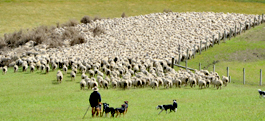Pretty much any product wrapped in plastic in a regular supermarket has been made by a machine. Ignore the pictures on the label of smiling workers or farms and imagine a really BIG machine.
It doesn’t matter how many factories I go to. They are always surprising. On a recent procurement trip to Japan, I toured three factories, all of which were for supermarket products (high-volume, low-quality products that I knew were not for me). In some regards, the tours were a waste of time, but it is always either enlightening or frightening to visit a factory so I will never turn down an invitation. In this case, I visited three: a fruit in jelly factory (a la those jello molds with fruit in them); a corn snack factory; and a ready to heat udon factory.
Some common characteristics of those factories were:
- Factories are staffed with uniformed Japanese workers that are somewhere between Willy Wonka and the product of 1980s era American factory worker nightmare.
- The factories are very clean and the workers are completely covered up. I was surprised that they were more covered up than in a slaughterhouse and then realized that it is probably because the foods these factories were making are ready to eat. With meat, you know that it is going to get cooked by a chef or consumer and that will kill any remaining bacteria. You have to take your shoes off before you step in the building. The only thing showing from behind your smock suit is your eyes. In some factories we had to go through a lint brush and then an “air shower” which basically puts you in a wind tunnel and sucks everything off of you.Everything in Japan is extremely clean, except the air which is apparently the fault of China. I’d be furious but the passive Japanese apparently just suck up the dirty air and hope they can sell the Chinese their clean air technology.
- No human hands touch the product once the raw material enters the stream. Wheat and water go in the mixer and cooked, bagged and chilled udon comes out the other end. A human doesn’t touch it until it places the individual bags into a box. Corn meal goes in and bagged popped corn snacks come out the other end. Jelly and fruit go in one end and a human hand doesn’t actually touch the product until someone in the supermarket removes it from a box and puts it on the shelf. That line is automated all the way through. The individual jelly cups get sealed, pasteurized in a hot water bath, chilled in a cold water bath, boxed, shrink-wrapped and even palletized by machine. Then an automated system moves the pallet into the warehouse.
One jelly line makes 6,000 pieces per hour. I know you can do math, but that is 100 per minute or 1.66 pieces per SECOND. No human can work that fast. The fruit jelly factory had 12 lines making 1,100,000 units per day. Staggering! Imagine a football field of machines moving product through the line and out the door.
The noodle factory might have been the most interesting process to see because they basically take a huge batch of dough and then roll it out through a series of six rollers. Each roller thinned the continuous pasta sheet a little bit more and also moved faster because it had to process more length than the previous roller. Once at the right thickness, it went through a cutter that sliced it into noodles, then it got cut into 8 inch lengths and dropped through a hole in the floor into the giant boiler that was on the level below. Each portion landed in a cage that went through the boiler, then through a water bath with lactic acid that had a low enough pH to make the noodles such that refrigeration was not necessary on the shelf. Then into a chiller, then into a bag. Once it was bagged it went into another hot water bath for pasteurization, then into another chiller.
The machines are enormous and staggering and automated. In some of these places there are probably more engineers than production line workers. Basically, any product that is on a mainstream supermarket shelf wrapped in plastic is made by machines. Know it. The level of automation is always staggering no matter how many of these places I see. I don’t see many, truth be told. Most of the non-meat producers that I visit are small-batch, hand-made artisanal products.
Some of the factories are shiny and new, others are a few decades old with big hunking rusty exteriors with steam billowing out from all cracks. Sadly, none of these factories allowed us to take pictures.


























 The Absoloms’ next door neighbors, the Crosses, are no less exceptional.
The Absoloms’ next door neighbors, the Crosses, are no less exceptional. 
























